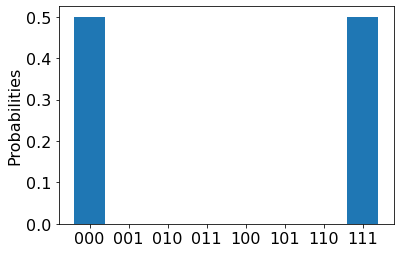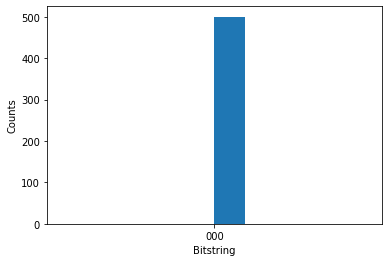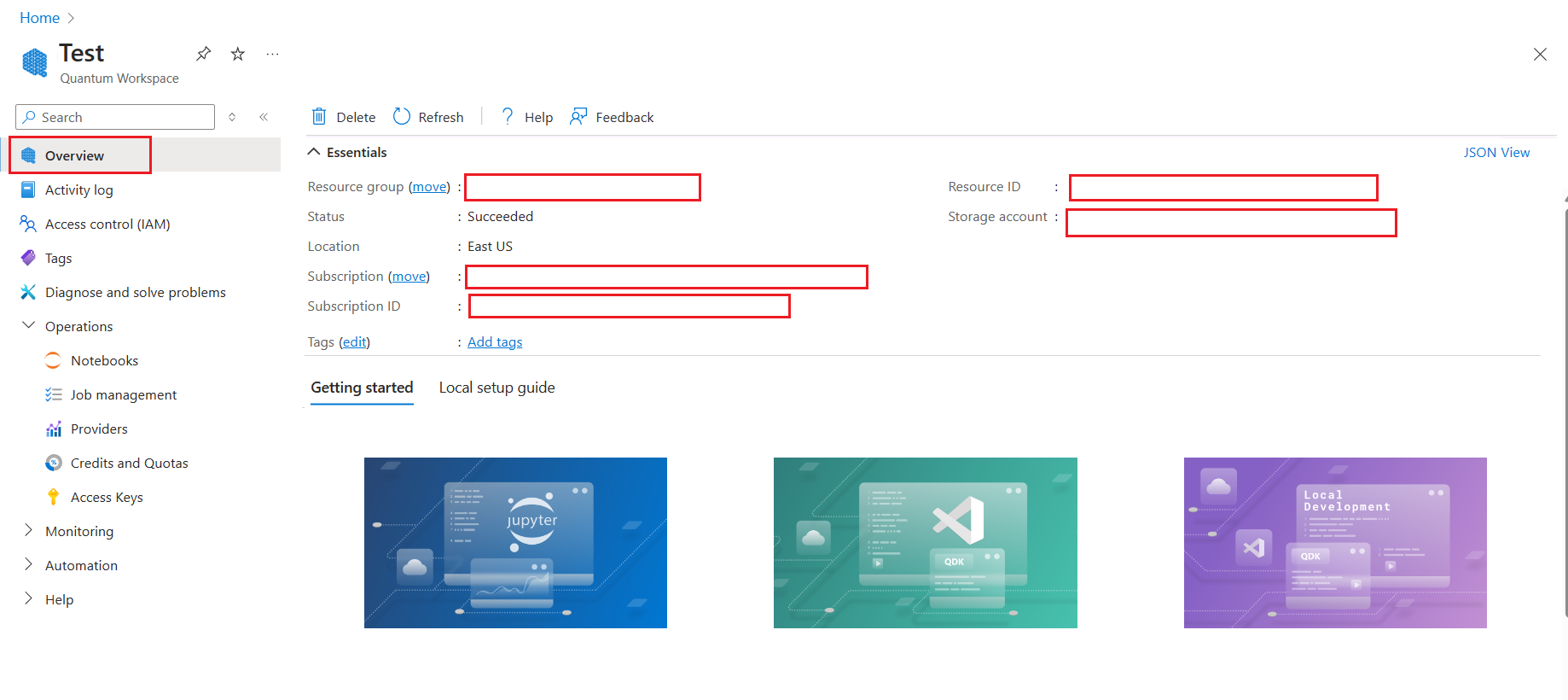How to submit specific formatted circuits to Azure Quantum
Learn how to use the azure-quantum Python package to submit circuits in specific formats to the Azure Quantum service. This article shows you how to submit circuits in the following formats:
For more information, see Quantum circuits.
Prerequisites
To run your circuits in a Notebook in Azure portal, you need:
- An Azure account with an active subscription. If you don’t have an Azure account, register for free and sign up for a pay-as-you-go subscription.
- An Azure Quantum workspace. For more information, see Create an Azure Quantum workspace.
To develop and run your circuits in Visual Studio Code, you also need:
A Python environment with Python and Pip installed.
VS Code with the Azure Quantum Development Kit, Python, and Jupyter extensions installed.
The Azure Quantum
qsharp,azure-quantum, andipykernelpackages.python -m pip install --upgrade qsharp azure-quantum ipykernel
Create a new Jupyter Notebook
You can create a notebook in VS Code or directly in the Azure Quantum portal.
- Log in to the Azure portal and select the workspace from the previous step.
- In the left blade, select Notebooks.
- Click My Notebooks and click Add New.
- In Kernel Type, select IPython.
- Type a name for the file, and click Create file.
When your new Notebook opens, it automatically creates the code for the first cell, based on your subscription and workspace information.
from azure.quantum import Workspace
workspace = Workspace (
resource_id = "", # Your resource_id
location = "" # Your workspace location (for example, "westus")
)
Submit QIR-formatted circuits
Quantum Intermediate Representation (QIR) is an intermediate representation which serves as a common interface between quantum programming languages/frameworks and targeted quantum computation platforms. For more information, see Quantum Intermediate Representation.
Create the QIR circuit. For example, the following code creates a simple entanglement circuit.
QIR_routine = """%Result = type opaque %Qubit = type opaque define void @ENTRYPOINT__main() #0 { call void @__quantum__qis__h__body(%Qubit* inttoptr (i64 0 to %Qubit*)) call void @__quantum__qis__cx__body(%Qubit* inttoptr (i64 0 to %Qubit*), %Qubit* inttoptr (i64 1 to %Qubit*)) call void @__quantum__qis__h__body(%Qubit* inttoptr (i64 2 to %Qubit*)) call void @__quantum__qis__cz__body(%Qubit* inttoptr (i64 2 to %Qubit*), %Qubit* inttoptr (i64 0 to %Qubit*)) call void @__quantum__qis__h__body(%Qubit* inttoptr (i64 2 to %Qubit*)) call void @__quantum__qis__h__body(%Qubit* inttoptr (i64 3 to %Qubit*)) call void @__quantum__qis__cz__body(%Qubit* inttoptr (i64 3 to %Qubit*), %Qubit* inttoptr (i64 1 to %Qubit*)) call void @__quantum__qis__h__body(%Qubit* inttoptr (i64 3 to %Qubit*)) call void @__quantum__qis__mz__body(%Qubit* inttoptr (i64 2 to %Qubit*), %Result* inttoptr (i64 0 to %Result*)) #1 call void @__quantum__qis__mz__body(%Qubit* inttoptr (i64 3 to %Qubit*), %Result* inttoptr (i64 1 to %Result*)) #1 call void @__quantum__rt__tuple_record_output(i64 2, i8* null) call void @__quantum__rt__result_record_output(%Result* inttoptr (i64 0 to %Result*), i8* null) call void @__quantum__rt__result_record_output(%Result* inttoptr (i64 1 to %Result*), i8* null) ret void } declare void @__quantum__qis__ccx__body(%Qubit*, %Qubit*, %Qubit*) declare void @__quantum__qis__cx__body(%Qubit*, %Qubit*) declare void @__quantum__qis__cy__body(%Qubit*, %Qubit*) declare void @__quantum__qis__cz__body(%Qubit*, %Qubit*) declare void @__quantum__qis__rx__body(double, %Qubit*) declare void @__quantum__qis__rxx__body(double, %Qubit*, %Qubit*) declare void @__quantum__qis__ry__body(double, %Qubit*) declare void @__quantum__qis__ryy__body(double, %Qubit*, %Qubit*) declare void @__quantum__qis__rz__body(double, %Qubit*) declare void @__quantum__qis__rzz__body(double, %Qubit*, %Qubit*) declare void @__quantum__qis__h__body(%Qubit*) declare void @__quantum__qis__s__body(%Qubit*) declare void @__quantum__qis__s__adj(%Qubit*) declare void @__quantum__qis__t__body(%Qubit*) declare void @__quantum__qis__t__adj(%Qubit*) declare void @__quantum__qis__x__body(%Qubit*) declare void @__quantum__qis__y__body(%Qubit*) declare void @__quantum__qis__z__body(%Qubit*) declare void @__quantum__qis__swap__body(%Qubit*, %Qubit*) declare void @__quantum__qis__mz__body(%Qubit*, %Result* writeonly) #1 declare void @__quantum__rt__result_record_output(%Result*, i8*) declare void @__quantum__rt__array_record_output(i64, i8*) declare void @__quantum__rt__tuple_record_output(i64, i8*) attributes #0 = { "entry_point" "output_labeling_schema" "qir_profiles"="base_profile" "required_num_qubits"="4" "required_num_results"="2" } attributes #1 = { "irreversible" } ; module flags !llvm.module.flags = !{!0, !1, !2, !3} !0 = !{i32 1, !"qir_major_version", i32 1} !1 = !{i32 7, !"qir_minor_version", i32 0} !2 = !{i32 1, !"dynamic_qubit_management", i1 false} !3 = !{i32 1, !"dynamic_result_management", i1 false} """Create a
submit_qir_jobhelper function to submit the QIR circuit to a target. Note that the input and output data formats are specified asqir.v1andmicrosoft.quantum-results.v1, respectively.# Submit the job with proper input and output data formats def submit_qir_job(target, input, name, count=100): job = target.submit( input_data=input, input_data_format="qir.v1", output_data_format="microsoft.quantum-results.v1", name=name, input_params = { "entryPoint": "ENTRYPOINT__main", "arguments": [], "count": count } ) print(f"Queued job: {job.id}") job.wait_until_completed() print(f"Job completed with state: {job.details.status}") #if job.details.status == "Succeeded": result = job.get_results() return resultSelect a target and submit the QIR circuit to Azure Quantum. For example, to submit the QIR circuit to the IonQ simulator target:
target = workspace.get_targets(name="ionq.simulator") result = submit_qir_job(target, QIR_routine, "QIR routine") result{'Histogram': ['(0, 0)', 0.5, '(1, 1)', 0.5]}
Submit a circuit with a provider-specific format to Azure Quantum
Besides QIR languages, such as Q# or Qiskit, you can submit quantum circuits in provider-specific formats to Azure Quantum. Each provider has its own format for representing quantum circuits.
Submit a circuit to IonQ using JSON format
Create a quantum circuit using the language-agnostic JSON format supported by the IonQ targets, as described in the IonQ API documentation. For example, the following sample creates a superposition between three qubits:
circuit = { "qubits": 3, "circuit": [ { "gate": "h", "target": 0 }, { "gate": "cnot", "control": 0, "target": 1 }, { "gate": "cnot", "control": 0, "target": 2 }, ] }Submit the circuit to the IonQ target. The following example uses the IonQ simulator, which returns a
Jobobject.target = workspace.get_targets(name="ionq.simulator") job = target.submit(circuit)Wait until the job is complete and then fetch the results.
results = job.get_results() print(results)..... {'duration': 8240356, 'histogram': {'0': 0.5, '7': 0.5}}You can then visualize the results using Matplotlib.
import pylab as pl pl.rcParams["font.size"] = 16 hist = {format(n, "03b"): 0 for n in range(8)} hist.update({format(int(k), "03b"): v for k, v in results["histogram"].items()}) pl.bar(hist.keys(), hist.values()) pl.ylabel("Probabilities")
Before running a job on the QPU, you should estimate how much it will cost to run.
Note
For the most current pricing details, see IonQ Pricing, or find your workspace and view pricing options in the "Provider" tab of your workspace via: aka.ms/aq/myworkspaces.
Submit a circuit to PASQAL using Pulser SDK
To submit a circuit to PASQAL, you can use the Pulser SDK to create pulse sequences and submit them to the PASQAL target.
Install the Pulser SDK
Pulser is a framework for composing, simulating and executing pulse sequences for neutral-atom quantum devices. It's designed by PASQAL as a pass-through to submit quantum experiments to their quantum processors. For more information, see Pulser documentation.
To submit the pulse sequences, first install the Pulser SDK packages:
try:
import pulser
except ImportError:
!pip -q install pulser
Create a quantum register
You need to define both a register and a layout before proceeding. The register specify where atoms will be arranged, while the layout specifies the positioning of traps necessary to capture and structure these atoms within the register.
For details on layouts, see the Pulser documentation.
First, you create a 'devices' object to import the PASQAL quantum computer target, Fresnel.
from pulser_pasqal import PasqalCloud devices = PasqalCloud().fetch_available_devices() QPU = devices["FRESNEL"]
Pre-calibrated layouts
The device defines a list of pre-calibrated layouts. You can build your register out of one of these layouts.
This is the recommended option because it will improve the performance of the QPU.
Option 1: Define your register using pre-calibrated layouts
Inspect the layouts available on Fresnel and define your register from this layout. Check the pulser documentation for more information on how to do that.
Example:
# let's say we are interested in the first layout available on the device layout = QPU.pre_calibrated_layouts[0] # Select traps 1, 3 and 5 of the layout to define the register traps = [1,3,5] reg = layout.define_register(*traps) # You can draw the resulting register to verify it matches your expectations reg.draw()
Arbitrary layouts
If pre-calibrated layouts do not satisfy the requirements of your experiment, you can create a custom layout.
For any given arbitrary register, a neutral-atom QPU will place traps according to the layout, which must then undergo calibration. Since each calibration requires time, it is generally advisable to reuse an existing calibrated layout whenever possible
Option 2: Automatically derive a layout from your defined register
This option allows for the automatic generation of a layout based on a specified register. However, for large registers, this process may yield sub-optimal solutions due to limitations in the algorithm used to create the layout.
qubits = { "q0": (0, 0), "q1": (0, 10), "q2": (8, 2), "q3": (1, 15), "q4": (-10, -3), "q5": (-8, 5), } reg = Register(qubits).with_automatic_layout(device)Option 3: Define your register using a manually defined layout
- Create an arbitrary layout with 20 traps randomly positioned in a 2D plane
import numpy as np # Generating random coordinates np.random.seed(301122) # Keeps results consistent between runs traps = np.random.randint(0, 30, size=(20, 2)) traps = traps - np.mean(traps, axis=0) # Creating the layout layout = RegisterLayout(traps, slug="random_20")- Define your register with specific trap IDs
trap_ids = [4, 8, 19, 0] reg = layout.define_register(*trap_ids, qubit_ids=["a", "b", "c", "d"]) reg.draw()
Write a pulse sequence
The neutral atoms are controlled with laser pulses. The Pulser SDK allows you to create pulse sequences to apply to the quantum register.
First, you define the pulse sequence attributes by declaring the channels that will be used to control the atoms. To create a
Sequence, you need to provide aRegisterinstance along with the device where the sequence will be executed. For example, the following code declares one channel:ch0.Note
You can use the
QPU = devices["FRESNEL"]device or import a virtual device from Pulser for more flexibility. The use of aVirtualDeviceallows for sequence creation that is less constrained by device specifications, making it suitable for execution on an emulator. For more information, see Pulser documentation.from pulser import Sequence seq = Sequence(reg, QPU) # print the available channels for your sequence print(seq.available_channels) # Declare a channel. In this example we will be using `rydberg_global` seq.declare_channel("ch0", "rydberg_global")Add pulses to your sequence. To do so, you create and add pulses to the channels you declared. For example, the following code creates a pulse and adds it to channel
ch0.from pulser import Pulse from pulser.waveforms import RampWaveform, BlackmanWaveform import numpy as np amp_wf = BlackmanWaveform(1000, np.pi) det_wf = RampWaveform(1000, -5, 5) pulse = Pulse(amp_wf, det_wf, 0) seq.add(pulse, "ch0") seq.draw()The following image shows the pulse sequence.

Convert the sequence to a JSON string
To submit the pulse sequences, you need to convert the Pulser objects into a JSON string that can be used as input data.
import json
# Convert the sequence to a JSON string
def prepare_input_data(seq):
input_data = {}
input_data["sequence_builder"] = json.loads(seq.to_abstract_repr())
to_send = json.dumps(input_data)
return to_send
Submit the pulse sequence to PASQAL target
First, you need to set the proper input and output data formats. For example, the following code sets the input data format to
pasqal.pulser.v1and the output data format topasqal.pulser-results.v1.# Submit the job with proper input and output data formats def submit_job(target, seq, shots): job = target.submit( input_data=prepare_input_data(seq), # Take the JSON string previously defined as input data input_data_format="pasqal.pulser.v1", output_data_format="pasqal.pulser-results.v1", name="PASQAL sequence", shots=shots # Number of shots ) print(f"Queued job: {job.id}") return jobNote
The time required to run a job on the QPU depends on current queue times. You can view the average queue time for a target by selecting the Providers blade of your workspace.
Submit the program to PASQAL. Before submitting your code to real quantum hardware, you can test your code using the emulator
pasqal.sim.emu-tnas a target.target = workspace.get_targets(name="pasqal.sim.emu-tn") # Change to "pasqal.qpu.fresnel" to use Fresnel QPU job = submit_job(target, seq, 10) job.wait_until_completed() print(f"Job completed with state: {job.details.status}") result = job.get_results() print(result){ "1000000": 3, "0010000": 1, "0010101": 1 }
Submit a circuit to Quantinuum using OpenQASM
Create a quantum circuit in the OpenQASM representation. For example, the following example creates a Teleportation circuit:
circuit = """OPENQASM 2.0; include "qelib1.inc"; qreg q[3]; creg c0[3]; h q[0]; cx q[0], q[1]; cx q[1], q[2]; measure q[0] -> c0[0]; measure q[1] -> c0[1]; measure q[2] -> c0[2]; """Optionally, you can load the circuit from a file:
with open("my_teleport.qasm", "r") as f: circuit = f.read()Submit the circuit to the Quantinuum target. The following example uses the Quantinuum API validator, which returns a
Jobobject.target = workspace.get_targets(name="quantinuum.sim.h1-1sc") job = target.submit(circuit, shots=500)Wait until the job is complete and then fetch the results.
results = job.get_results() print(results)........ {'c0': ['000', '000', '000', '000', '000', '000', '000', ... ]}You can then visualize the results using Matplotlib.
import pylab as pl pl.hist(results["c0"]) pl.ylabel("Counts") pl.xlabel("Bitstring")
Looking at the histogram, you may notice that the random number generator returned 0 every time, which is not very random. This is because that, while the API Validator ensures that your code will run successfully on Quantinuum hardware, it also returns 0 for every quantum measurement. For a true random number generator, you need to run your circuit on quantum hardware.
Before running a job on the QPU, you should estimate how much it will cost to run.
Note
For the most current pricing details, see Azure Quantum pricing, or find your workspace and view pricing options in the "Provider" tab of your workspace via: aka.ms/aq/myworkspaces.
Submit a circuit to Rigetti using Quil
The easiest way to submit Quil jobs is using the pyquil-for-azure-quantum package, as it allows you to use the tools and documentation of the pyQuil library. Without this package, pyQuil can be used to construct Quil programs but not to submit them to Azure Quantum.
You can also construct Quil programs manually and submit them using the azure-quantum package directly.
First, load the required imports.
from pyquil.gates import CNOT, MEASURE, H from pyquil.quil import Program from pyquil.quilbase import Declare from pyquil_for_azure_quantum import get_qpu, get_qvmUse the
get_qvmorget_qpufunction to get a connection to the QVM or QPU.qc = get_qvm() # For simulation # qc = get_qpu("Ankaa-9Q-3") for submitting to a QPUCreate a Quil program. Any valid Quil program is accepted, but the readout must be named
ro.program = Program( Declare("ro", "BIT", 2), H(0), CNOT(0, 1), MEASURE(0, ("ro", 0)), MEASURE(1, ("ro", 1)), ).wrap_in_numshots_loop(5) # Optionally pass to_native_gates=False to .compile() to skip the compilation stage result = qc.run(qc.compile(program)) data_per_shot = result.readout_data["ro"]Here,
data_per_shotis anumpyarray, so you can usenumpymethods.assert data_per_shot.shape == (5, 2) ro_data_first_shot = data_per_shot[0] assert ro_data_first_shot[0] == 1 or ro_data_first_shot[0] == 0Print out all the data.
print("Data from 'ro' register:") for i, shot in enumerate(data_per_shot): print(f"Shot {i}: {shot}")
Important
Submitting multiple circuits on a single job is currently not supported. As a workaround you can call the backend.run method to submit each circuit asynchronously, then fetch the results of each job. For example:
jobs = []
for circuit in circuits:
jobs.append(backend.run(circuit, shots=N))
results = []
for job in jobs:
results.append(job.result())
